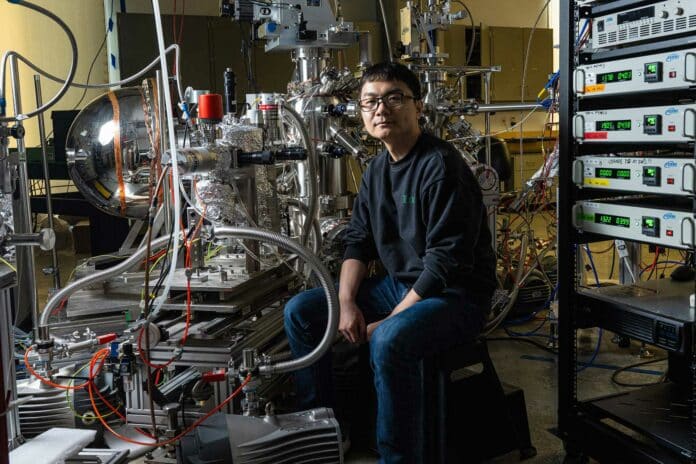Electronic correlation effects in quantum materials arise when there is a significant on-site Coulomb repulsion or low electron kinetic energy. These effects are prominent in materials like cuprate superconductors and heavy-fermion systems. Both effects can coexist in certain materials, such as twisted bilayer graphene and geometrically frustrated metals. The goal is to create materials with correlated topological flat bands at the Fermi level, enhancing our ability to manipulate and control their electronic properties.
Rice University scientists have identified a unique material—a 3D crystalline metal—that exhibits a combination of quantum correlations and crystal structure geometry, resulting in the confinement of electron movement.
Scientists also describe the theoretical design principle and experimental methodology that guided the research team to the material. One part copper, two parts vanadium, and four parts sulfur, the alloy features a 3D pyrochlore lattice consisting of corner-sharing tetrahedra.
The search for materials with unique quantum properties, such as the frustration of electron movement leading to immobilization, has led researchers to focus on quantum materials. In this context, quantum entanglement, resulting from solid electron interactions, plays a crucial role in inducing peculiar electronic behaviors.
The phenomenon of frustrating electron movement and effectively locking them in place is akin to the interference of waves, creating standing waves that do not propagate. The study of geometrically frustrated lattice materials involves investigating electronic wave functions that undergo destructive interference, preventing the usual movement of electrons.
Electron localization in metals and semimetals forms flat electronic bands, commonly referred to as flat bands. Recent research has highlighted the discovery that certain 2D crystals, such as Kagome lattices, exhibit flat bars due to the geometric arrangement of atoms.
The study provides empirical evidence of this effect occurring in a 3D material. By utilizing angle-resolved photoemission spectroscopy (ARPES), researchers mapped the band structure of a copper-vanadium-sulfur material and identified a distinct flat band with unique characteristics.
Study co-corresponding author Ming Yi, a Rice experimental physicist, said, “It turns out that both types of physics are important in this material. The geometric frustration aspect was there, as theory had predicted. The pleasant surprise was that correlation effects produced the flat band at the Fermi level, where it can actively participate in determining the physical properties.”
In solid-state matter, electrons exist in quantum states organized into bands. These electronic bands can be visualized as rungs on a ladder, with electrostatic repulsion dictating the maximum number of electrons each rung can accommodate. The Fermi level is a fundamental property of materials and plays a crucial role in defining their band structure. It represents the energy level of the highest occupied electronic ladder.
Rice theoretical physicist and study co-corresponding author Qimiao Si said, “It’s the very first work to really show not only this cooperation between geometric- and interaction-driven frustration but also the next stage, which is getting electrons to be in the same space at the top of the (energy) ladder, where there’s a maximal chance of their reorganizing into interesting and potentially functional new phases.”
“The predictive methodology or design principle that his research group used in the study may also prove useful to theorists who study quantum materials with other crystal lattice structures.”
“The pyrochlore is not the only game in town,” Si said. “This new design principle allows theorists to predictively identify materials in which flat bands arise due to strong electron correlations.”
Yi said there is also plenty of room for further experimental exploration of pyrochlore crystals.
“This is just the tip of the iceberg. This is 3D, which is new, and given how many surprising findings there have been on Kagome lattices, I’m envisioning that there could be equally or even more exciting discoveries to be made in the pyrochlore materials.”
Journal Reference:
- Huang, J., Chen, L., Huang, Y. et al. Non-Fermi liquid behaviour in a correlated flat-band pyrochlore lattice. Nat. Phys. (2024). DOI: 10.1038/s41567-023-02362-3
